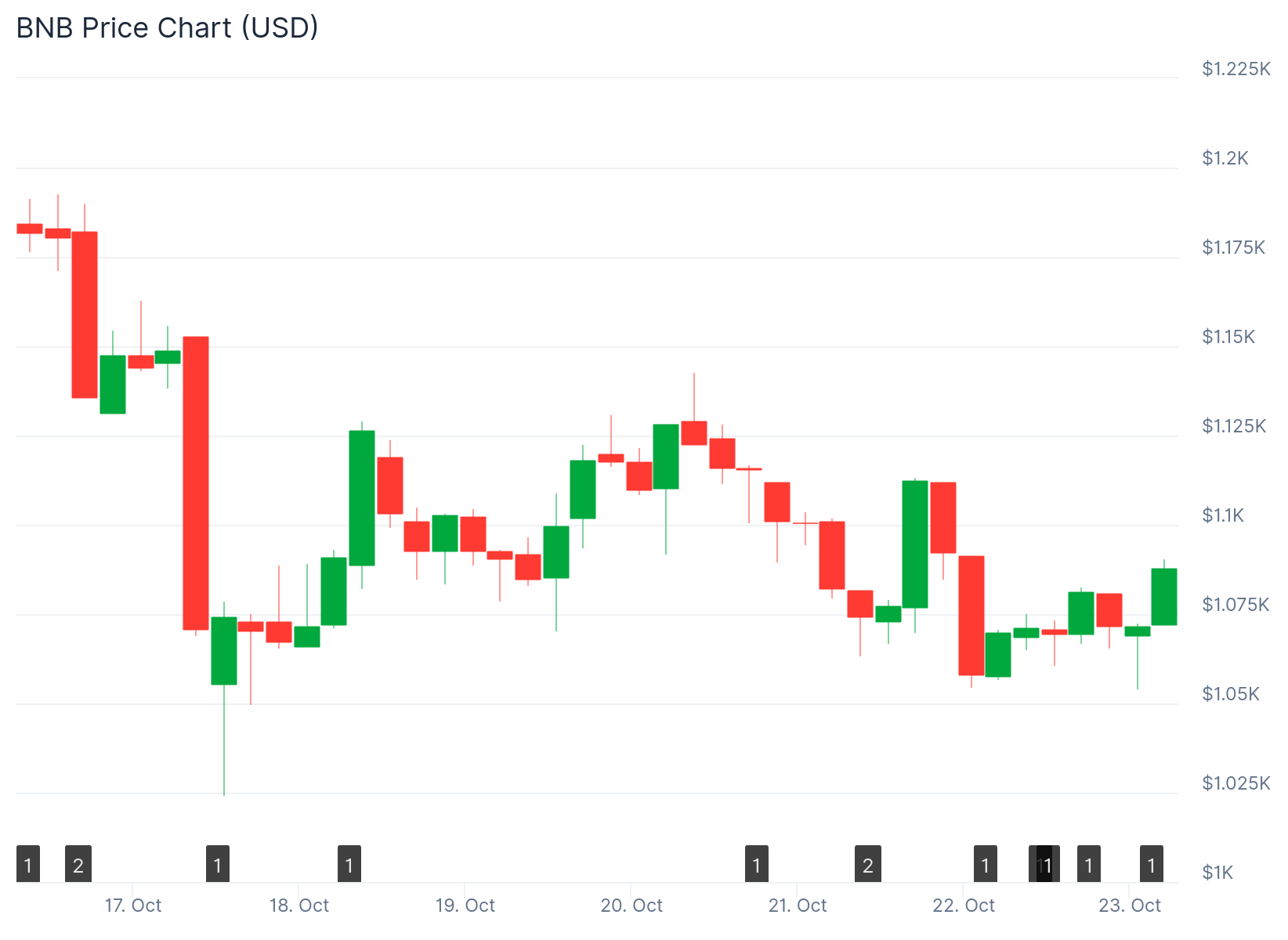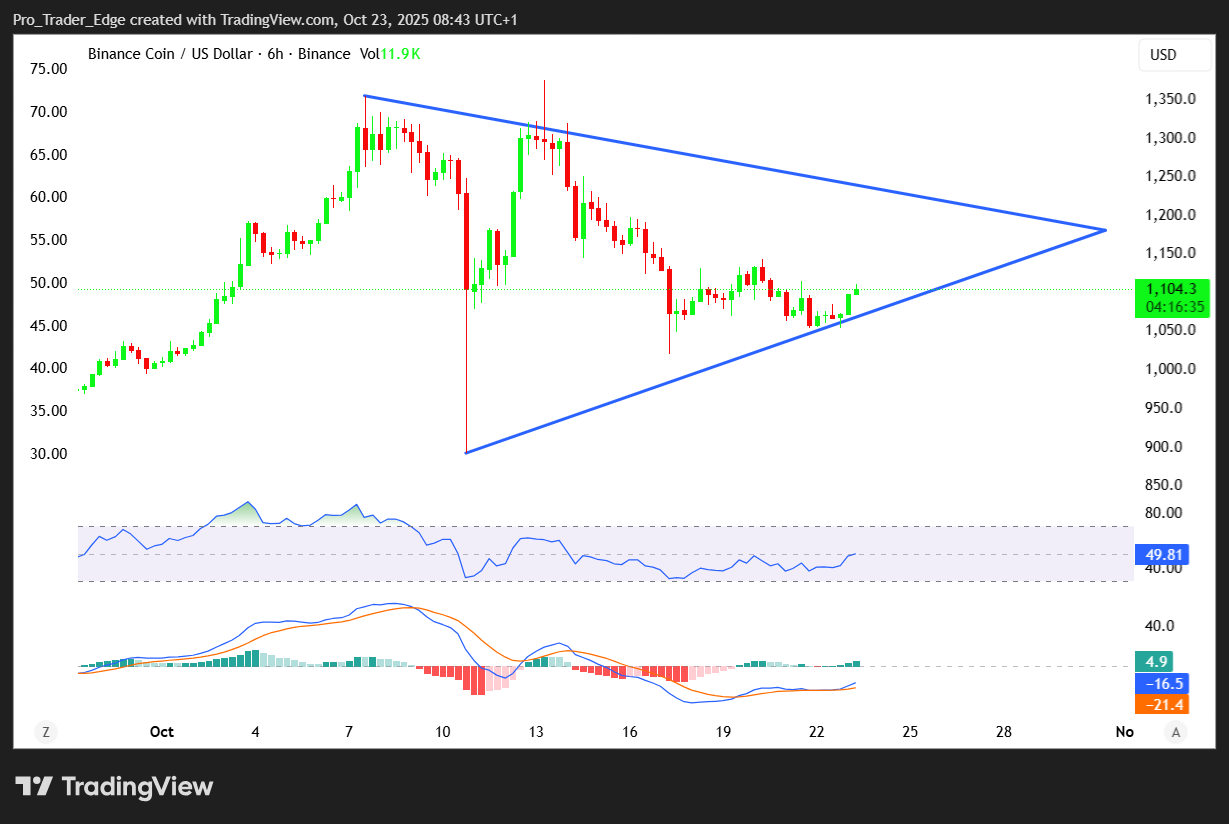BNB Price: Treasury Companies Buy While Retail Traders Sell
TLDR
- BNB is trading around $1,072 after dropping 10% in seven days and needs to hold $1,000 support to prevent a deeper correction to $845.
- Technical analysis shows BNB broke below a descending triangle pattern on the six-hour chart with a measured downside target of $845.
- Spot taker cumulative volume delta data shows sell orders have become dominant since BNB hit its all-time high of $1,375, indicating more supply than demand.
- Applied DNA Sciences purchased 4,908 BNB tokens worth $5.3 million and has indirect exposure to 10,647 BNB through a $27 million private investment deal.
- CEA Industries now holds 500,000 BNB tokens at an average price of $870 per token and aims to own 1% of total BNB supply by year end.
BNB is trading at $1,072 after declining 10% over the past seven days. The token is testing critical support levels that could determine its near-term direction.
 BNB Price
BNB Price
Technical and onchain data suggests bulls need to defend the $1,000 level. A failure to hold this support could trigger a correction toward $845.
The token dropped toward the $1,050 support zone earlier this week. Buyers are attempting to push the price above this level to prevent further losses.
Analyst BlockchainBaller said BNB is holding around the $1,060 support area. The analyst noted that buyers are showing interest at this level.
A move toward $1,140 could happen if the price breaks above the $1,107 to $1,120 range. This range lines up with the 200-period and 50-period simple moving averages.
The next resistance sits at $1,180. This level matches the location of the 100-period simple moving average.
On the downside, the first support area lies between $1,050 and $1,020. This level was reached on October 15.
The $1,000 psychological level represents the next line of defense. This area has provided support since September 30.
A close below $1,000 could push the price down to between $955 and $930. The lower end of this range marks the September 25 low.
A deeper correction could send the token to test $874. This level represents the October 11 wick.
Breaking Below the Triangle Pattern
Data shows BNB breaking below a descending triangle on the six-hour chart. Failure to close above the triangle’s support line at $1,069 could continue the downward move.
 Source: TradingView
Source: TradingView
The measured target from this pattern sits at $845. This would represent a 21% decline from current levels.
The relative strength index has dropped from 86 to 41 over the past two weeks. The indicator is now moving below the 50 mark.
A drop below $1,020 support could suggest the token has topped out in the short term. This would confirm the bearish technical setup.
Trading Volume Shows Seller Control
The 90-day spot taker cumulative volume delta reveals sell orders have become dominant. This metric measures the difference between buy and sell volume over three months.
Sell-side pressure has controlled the order book since last Friday. This started after BNB hit an all-time high of $1,375.
Negative cumulative volume delta indicates profit-taking among traders. The red bars show sellers are taking control as demand weakens.
More sell orders are being placed than buy orders in the current market. Most holders are in profit at current price levels.
This suggests more supply than demand exists right now. This imbalance typically signals the price may extend its correction.
Public Companies Add BNB to Balance Sheets
Applied DNA Sciences purchased 4,908 BNB tokens worth about $5.3 million on Wednesday. The biotech firm’s stock jumped over 50% during the trading day after the announcement.
The purchase followed a $27 million private investment deal. The financing combined $15.3 million in cash and stablecoins with $11.7 million in OBNB Trust units.
The company has indirect ownership of roughly 10,647 BNB total. The BNB-linked warrants need shareholder approval before tokens can be transferred.
Applied DNA plans to use proceeds to implement a yield-focused treasury strategy. Chief investment officer Patrick Horsman said the strategy will have direct and BNB equivalent exposure.
CEA Industries acquired 500,000 BNB tokens at an average price of about $870 per token. The Canadian vape company announced this purchase on Tuesday.
CEA announced its pivot to a BNB treasury company in July. The firm is currently the largest BNB treasury company.
The company aims to own 1% of total BNB supply by the end of the year. China Renaissance Holdings was reported in October to be raising $600 million to form a digital asset treasury to accumulate BNB.
BNB flipped XRP to become the third-largest cryptocurrency by market cap on October 7. The token hit a new all-time high of $1,370 on October 13 but is now trading around $1,080, down 21% from its peak.
The post BNB Price: Treasury Companies Buy While Retail Traders Sell appeared first on CoinCentral.
You May Also Like

Google's AP2 protocol has been released. Does encrypted AI still have a chance?

Metaplanet raises $1.4B to fuel BTC purchases and U.S. subsidiary launch
